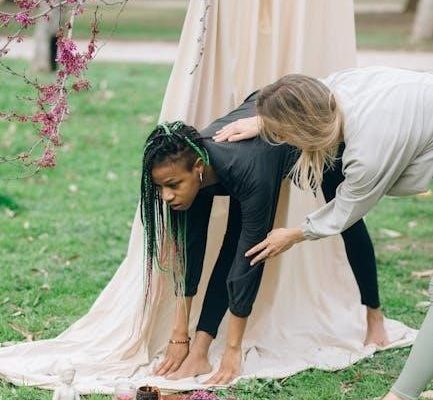Guided meditation is a practice where a leader directs participants through relaxation, focus, and mindfulness exercises. It enhances calm, reduces stress, and fosters self-awareness, accessible to all.
1.1 Understanding the Role of a Meditation Leader
A meditation leader guides participants through a structured experience, creating a safe and focused environment. Their role involves preparing sessions, using soothing tones, and employing techniques like visualization and breathwork. Leaders must stay attuned to the group’s energy, addressing distractions and emotional releases. Effective leaders foster trust and calm, helping participants deepen their practice. They also provide post-session support, encouraging mindfulness beyond the meditation. A strong personal practice and understanding of techniques are essential for leading authentically and compassionately.
1.2 Benefits of Guided Meditation for Participants
Guided meditation offers numerous benefits, including reduced stress, improved focus, and enhanced emotional well-being. It helps participants cultivate mindfulness and relaxation, even for those new to meditation. The structured format ensures a meaningful experience, while the leader’s guidance keeps participants on track. Regular practice can improve sleep quality, boost self-awareness, and foster a sense of calm in daily life. It also provides a safe space for emotional releases and personal growth. Participants often feel more centered and empowered, carrying these benefits into their personal and professional lives, leading to a more balanced and fulfilling existence.
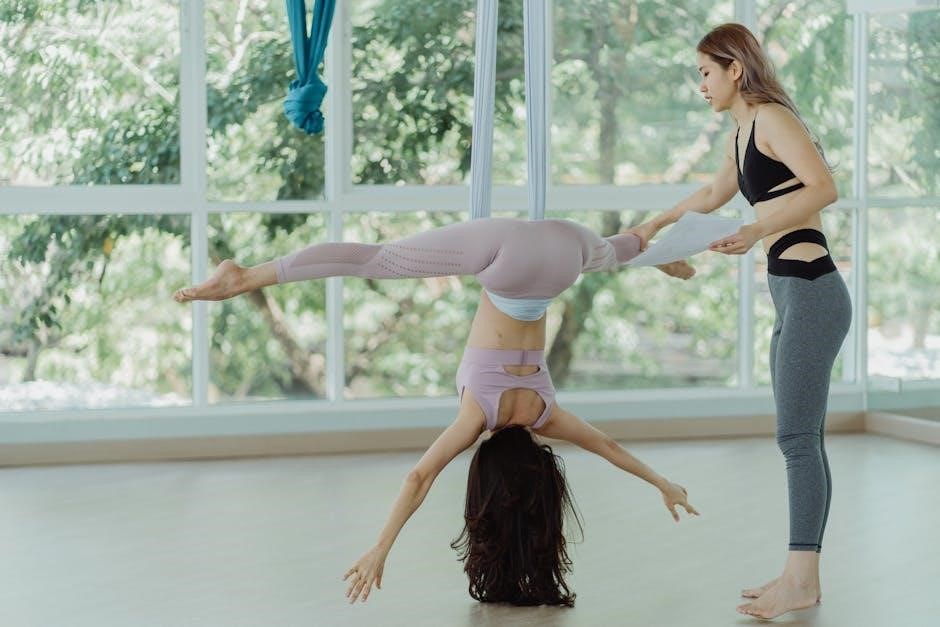
Preparation for Leading a Guided Meditation
Leading a guided meditation requires developing a strong personal practice, researching techniques, and understanding your audience. Preparation ensures confidence and creates a meaningful experience for participants.
2.1 Developing Personal Meditation Practice
Developing a personal meditation practice is foundational for leading others. Regular meditation helps cultivate mindfulness, emotional balance, and self-awareness, allowing you to embody the techniques you share. Consistency strengthens your ability to guide others authentically. Through personal practice, you can deeply understand the benefits and challenges, enabling you to address diverse participant experiences empathetically. A strong practice also enhances your confidence, creating a reassuring presence for those you lead. This personal journey enriches your guidance, making your sessions more meaningful and impactful for everyone involved.
2.2 Researching Meditation Techniques and Scripts
Researching meditation techniques and scripts is essential for effective leadership. Explore various methods, such as mindfulness, visualization, and breathwork, to create engaging sessions. Study scripts from experienced guides to understand pacing, tone, and structure. Familiarize yourself with diverse traditions and adapt them to suit your audience. Stay updated on current trends and scientific research to ensure your content is relevant and beneficial. This preparation enables you to craft meaningful meditations that resonate deeply, fostering a positive experience for participants. Continuous learning enhances your versatility and confidence as a guide.
2.4 Understanding the Target Audience
Understanding your audience is crucial for leading effective guided meditations. Identify their experience level, specific needs, and preferences to tailor your approach. For example, beginners may require simpler techniques, while advanced practitioners might benefit from deeper, more complex exercises. Consider their lifestyle, stressors, and goals to create relatable content. Recognize diverse backgrounds and adapt language to ensure inclusivity. This understanding allows you to design sessions that resonate personally, fostering engagement and maximizing benefits. A well-tailored approach ensures participants feel comfortable and supported throughout the meditation journey.

Creating a Peaceful Environment
Designing a space that promotes relaxation and focus is key. Use seating, noise reduction, and soothing aesthetics to create a calming atmosphere for meditation sessions.
3.1 Choosing a Quiet and Comfortable Space
Selecting a quiet, serene environment is essential for guided meditation. Ensure the space is free from distractions, with comfortable seating options like cushions or chairs. Minimize background noise by choosing a room away from busy areas or using noise-reducing materials. Natural light and soft colors can enhance calmness. The space should accommodate the group size comfortably, fostering intimacy and focus. A well-prepared environment helps participants relax and engage fully with the meditation experience, setting the stage for a meaningful and transformative session.
3.2 Setting the Mood with Lighting and Music
Lighting and music play a crucial role in creating a calming atmosphere for guided meditation. Soft, warm lighting can help participants relax, while dimming harsh overhead lights reduces visual strain. Calming music or nature sounds, such as gentle instrumental melodies or ocean waves, can deepen the meditative experience. Ensure the volume is low enough to avoid distraction, allowing your voice to remain the focal point; These elements work together to create a soothing environment, helping participants transition into a peaceful state of mind and fully engage with the meditation practice.
3.3 Minimizing Distractions
To ensure a focused and immersive experience, it’s essential to minimize distractions during guided meditation. Begin by choosing a quiet space away from noise sources. Encourage participants to turn off electronic devices or place them on silent mode. Arrange seating comfortably to avoid physical discomfort. Additionally, consider the room’s temperature and airflow to maintain a pleasant environment. By addressing potential distractions beforehand, you create an atmosphere where participants can fully concentrate on the meditation practice without interruptions, allowing them to deepen their relaxation and connection to the experience.

Structuring the Meditation Session
A well-structured meditation session begins with an introduction, transitions into deep relaxation, and incorporates visualization techniques to guide participants through a seamless and transformative experience.
Starting with a warm welcome and a brief introduction sets the tone for a guided meditation. Leaders should explain the session’s purpose, creating a safe and inviting atmosphere. This helps participants feel comfortable and focused. A gentle voice and calm demeanor are essential, ensuring everyone feels at ease. The introduction should outline what to expect, encouraging mindfulness and presence. By setting clear intentions, the leader guides participants into a receptive state, fostering a deeper connection to the meditation practice ahead. This initial step builds trust and readiness for the journey inward.
4.2 Guiding Through Relaxation and Breathing
Begin by guiding participants into a state of deep relaxation using soothing language. Encourage them to focus on their breath, emphasizing slow, deep inhalations and exhalations. Transition smoothly from the introduction, helping them release tension by scanning their body from head to toe. Use gentle reminders to let go of distractions and immerse in the present moment. Breathing techniques, such as counting breaths or observing the breath’s sensation, can enhance calmness. Ensure your voice remains steady and reassuring, pacing the session to allow participants to fully unwind and prepare for deeper meditation.
4.3 Incorporating Visualization Techniques
Visualization is a powerful tool in guided meditation, helping participants connect with their inner selves. Begin by guiding them to imagine a peaceful scene, such as a serene beach or a tranquil forest. Use vivid, descriptive language to paint a mental picture, encouraging them to engage all senses—sight, sound, smell, and touch. For example, describe the warmth of the sun or the sound of waves gently crashing. Allow time for participants to fully immerse in the imagery, then gradually transition to a deeper state of relaxation or reflection. This technique fosters emotional release and inner clarity, enhancing the meditation experience.
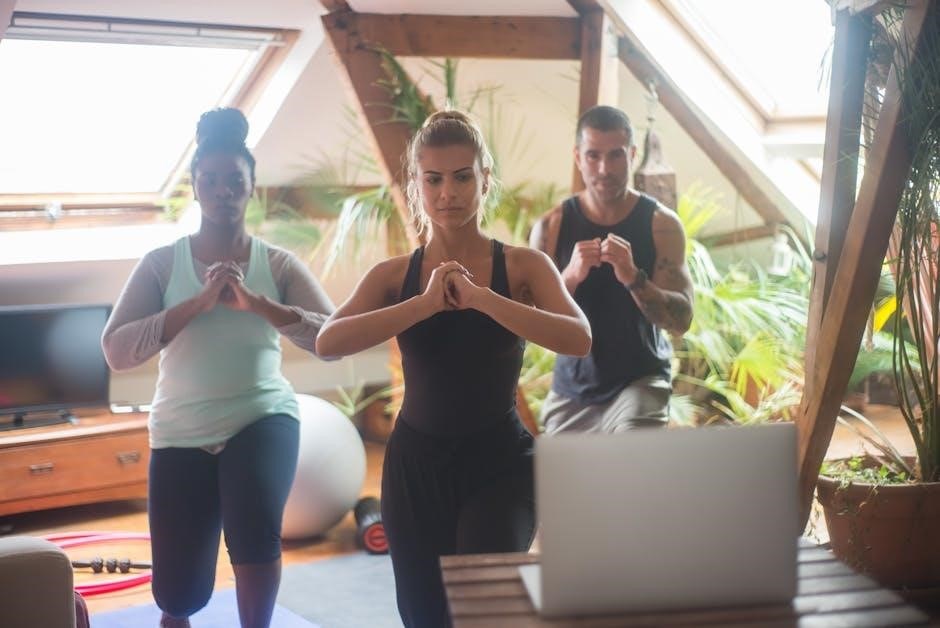
Delivery Techniques
Effective delivery involves a calm tone, clear pacing, and positive affirmations. Use soothing language to create a serene atmosphere, ensuring participants feel relaxed and focused throughout the session.
5.1 Using a Calming and Soothing Voice
Your voice is a powerful tool in guided meditation. Speak slowly and gently, avoiding abrupt tones. Maintain a steady pitch to create a sense of stability and calmness. Pause occasionally to allow participants to absorb the experience fully. Soft modulation in volume can enhance emotional connection, making the session more immersive. Practice your delivery to ensure it feels natural and authentic, fostering trust and relaxation among participants. A soothing voice helps participants let go of tension, making the meditation more effective and transformative. Consistency is key to maintaining a peaceful atmosphere throughout the session.
5.2 Employing Positive Affirmations
Positive affirmations are powerful tools to enhance guided meditation. They help participants reframe negative thoughts and cultivate a positive mindset. Use uplifting phrases such as, “You are calm and capable,” or “You deserve peace and happiness.” Deliver affirmations with conviction, allowing participants to absorb the words deeply. Timing is crucial—offer them during moments of relaxation or visualization. Avoid clichés; instead, tailor affirmations to the session’s theme or audience needs. Consistent use of affirmations fosters self-belief and emotional resilience, making the meditation experience more impactful and empowering for everyone involved. They serve as a bridge to inner confidence and clarity.
5.3 Pacing the Session Appropriately
Pacing is essential for a seamless guided meditation experience. Begin with a gentle introduction, allowing participants to settle and relax. Transition smoothly between stages, such as from breathing exercises to visualization, ensuring each step flows naturally. Speak at a moderate pace, avoiding rushing or dragging. Pause occasionally to let participants absorb the moment. Adjust your timing based on the group’s energy and feedback. Proper pacing ensures participants stay engaged and focused, making the session more effective and enjoyable. It helps in creating a balanced and transformative experience for all involved.

Handling Common Challenges
Addressing restlessness, resistance, and emotional releases requires empathy and adaptability. Leaders should stay calm, offer reassurance, and gently refocus participants to maintain a supportive environment.
6.1 Managing Restlessness or Distractions
When participants feel restless or distracted, gently acknowledge the sensation and guide them back to the present moment. Encourage deep breathing and patience, emphasizing that it’s natural for minds to wander. Offer reassuring phrases like, “It’s okay, simply bring your attention back to your breath.” Creating a safe space allows individuals to release tension without judgment. Leaders should remain calm and composed, modeling the behavior they wish to see in their participants. This approach helps maintain focus and fosters a deeper meditative experience for everyone involved.
6.2 Addressing Resistance or Skepticism
When participants express resistance or skepticism, approach the situation with empathy and understanding. Acknowledge their feelings and create a safe space for open dialogue. Encourage questions before the session begins to address concerns. Normalize any discomfort by emphasizing that meditation is a personal journey with no right or wrong way to experience it. Share testimonials or scientific benefits of meditation to build trust; Lead by example, demonstrating calm and patience, which can help ease doubts. Remind participants that even a few moments of focus can be transformative, fostering an open-minded atmosphere for exploration.
6.3 Supporting Emotional Releases
During guided meditation, emotional releases can occur as participants confront deep feelings. Leaders should create a safe, non-judgmental space, allowing emotions to surface naturally. Offer reassurance and acknowledge the experience without interruption. Provide practical support, such as tissues, if needed. Guide participants to focus on their breath to anchor themselves. Maintain a calm, empathetic demeanor to foster trust. Ensure the session progresses gently, avoiding pressure, and allow time for emotional processing. This supportive approach helps participants navigate their emotions constructively, enhancing the meditation’s therapeutic benefits.
Thank participants for their presence and openness. Encourage questions and reflections. Provide resources for further practice and support, fostering continued growth and mindfulness beyond the session.
7.1 Ending the Session Smoothly
Ending a guided meditation session smoothly is essential for providing closure. Leaders should gradually bring participants back to awareness by suggesting deep breaths and gentle movements. Acknowledge the time spent together and express gratitude for their presence. Avoid abrupt endings to ensure a calm transition. Offer a moment of silence or a closing phrase to seal the practice. This thoughtful conclusion helps participants integrate the experience into their day, leaving them refreshed and centered. A smooth ending reinforces the session’s benefits and fosters a sense of completion.
7.2 Providing Post-Meditation Guidance
After the session, guide participants in transitioning smoothly back to awareness. Encourage them to take their time and notice how they feel. Offer suggestions for integrating mindfulness into daily life, such as taking deep breaths or practicing gratitude. Provide resources or recommend meditation apps for continued practice. Acknowledge their effort and invite questions or reflections. This support helps participants apply the benefits of meditation beyond the session, fostering a deeper commitment to their well-being.
- Encourage mindfulness in daily activities.
- Offer resources for further practice.
- Support participants in their journey.
- Recommended apps: Headspace, Calm.
- Further reading: Meditation books, articles.
- Online communities: Forums, groups.

Additional Resources
Explore recommended apps like Headspace for guided sessions. Discover books on meditation techniques and join online communities for ongoing support and inspiration.
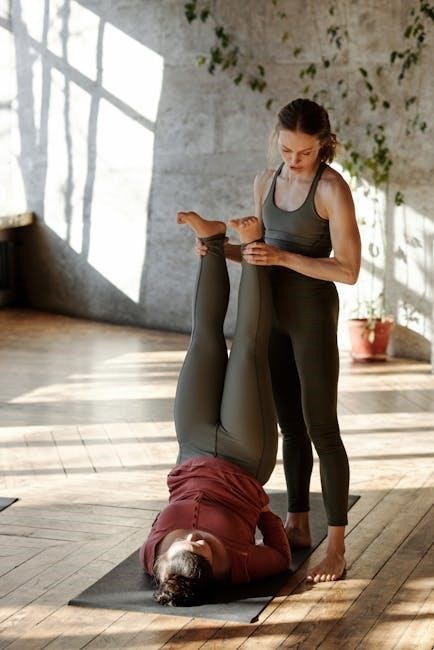
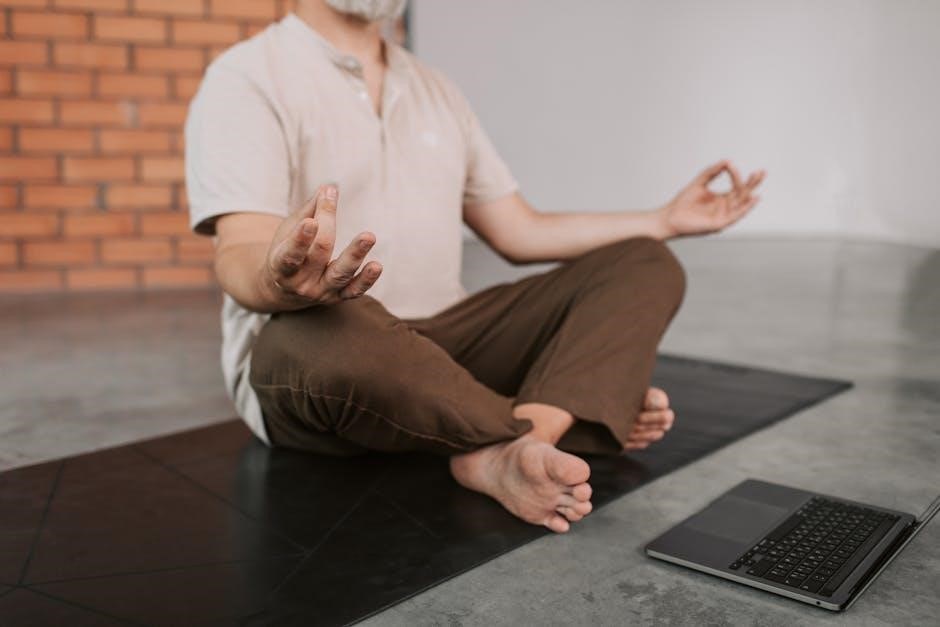
8.1 Recommending Further Reading
For deeper insights, explore books like “The Art of Meditation” and “Mindfulness: A Practical Guide.” Online articles and blogs offer tips on refining techniques and understanding benefits. Websites like Mindful.org provide valuable resources for leaders. Additionally, consider eBooks on meditation leadership, which share practical advice and real-world examples. Online courses on platforms like Udemy or Coursera can also enhance your knowledge. These resources will help you refine your skills and stay updated on the latest practices in guided meditation leadership.

8.2 Suggesting Useful Apps and Tools
Headspace and Calm are excellent apps for guided meditation, offering structured sessions for all levels. Insight Timer provides free meditations and a timer for personal practice. Apps like Buddhify and Meditation Studio cater to specific needs, such as stress or sleep. For leaders, tools like Google Slides or Canva can help create visually appealing scripts. Platforms like Zoom or YouTube Live are ideal for hosting virtual sessions. Additionally, ambient sound apps like Noisli or Rainy Mood can enhance the meditation atmosphere. These tools support both preparation and delivery, ensuring a seamless experience for participants.
